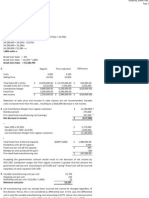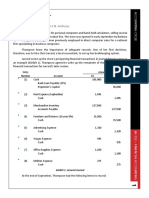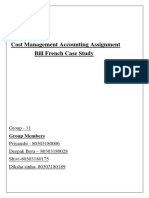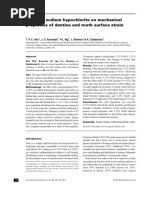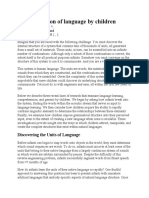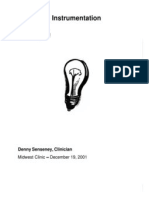Case 6-19 McGraw-Hill
Case 6-19 McGraw-Hill
Uploaded by
Kathleen Wellman HerberCopyright:
Available Formats
Case 6-19 McGraw-Hill
Case 6-19 McGraw-Hill
Uploaded by
Kathleen Wellman HerberOriginal Description:
Copyright
Available Formats
Share this document
Did you find this document useful?
Is this content inappropriate?
Copyright:
Available Formats
Case 6-19 McGraw-Hill
Case 6-19 McGraw-Hill
Uploaded by
Kathleen Wellman HerberCopyright:
Available Formats
Kathleen Herber CASE 619 The Case of the Plummeting Profits; Lean Production Required: 1 What characteristic of absorption
costing caused the drop in net operating income for the second . quarter and what could the controller have said to explain the problem? With absorption costing the net operating income relies on both production and sales so he was correct in his explanation, however he could have maybe explained better how since they had an under applied amount of overhead from their reduction in produced items and that by producing less that they were not able to absorb all of the fixed manufacturing costs into units of production. That is why you see this drop in net operating income for the second quarter. 2 Prepare a contribution format variable costing income statement for each quarter. .
First Quarter Sales Variable Expenses: Variable cost of good sold Variable selling and administrative expense Total Variable Expense Contribution margin Fixed Expenses: Fixed manufacturing overhead Fixed selling and administrative expense Total fixed expense Net operating income (loss) $480,000 96000 60000 156000 $324,000
Second Quarter $600,000 120000 75000 195000 $405,000
$180,000 140,000 $320,000 $4,000
$180,000 140,000 $320,000 $85,000
Selling and administrative expenses Less variable portion (12,000 units x $5.00 per unit) Total Fixed selling and administrative expenses
200,000 60,000 140,000
3 Reconcile the absorption costing and the variable costing net operating income figures for each
. quarter.
Reconciliation of Absorption costing and the Variable Costing Net income figures First Quarter Second Quarter Variable costing net operating income $4,000 $85,000 Deduct: Fixed manufacturing overhead cost released from inventory during the First Quarter (4,000 units $12 per unit) -48000 Add (deduct): Fixed manufacturing overhead cost deferred in inventory from the First Quarter to the Second Quarter (7,000 units $12 per unit) 84000 -84000 Add: Fixed manufacturing overhead cost deferred in inventory from the Second Quarter to the future (1,000 units $12 per unit) 12000 Absorption costing net operating income $40,000 $13,000
4 Identify and discuss the advantages and disadvantages of using the variable costing method for . internal reporting purposes. There are several advantages to using the variable costing method: ~Make is easier to estimate the profitability of products. ~Profit is unchanged by changes in inventories. ~Profit and sales move in the same direction. Some of the disadvantages using the variable costing method: ~Not able to use as an external report, you may run the risk of an auditor not excepting the financial statement. ~It may be difficult to determine what are fixed costs as apposed to variable costs. 5 Assume that the company had introduced Lean Production at the beginning of the second quarter, . resulting in zero ending inventory. (Sales and production during the first quarter remain the same.) a. How many units would have been produced during the second quarter under Lean Production? If we utilized the JIT Production theory, producing only enough units to meet the demands of sales the equation would be as follows: Units Sold. 15,000 Less units in Inventory at the beg of qtr.. Units produced in second qtr. for JIT 7,000 8,000
b. Starting with the third quarter, would you expect any difference between the net operating income reported under absorption costing and under variable costing? Explain why there would or would not be any difference. Starting with the third quarter there would be little or no difference between the net operating income reported under absorption costing and variable costing because there would be a lack of inventories. This would make it impossible to incorporate the fixed manufacturing overhead cost between the periods.
You might also like
- Case Study - Rayco Inc. Group 1Document4 pagesCase Study - Rayco Inc. Group 1bryan albertNo ratings yet
- Cases Inhouse ClassDocument5 pagesCases Inhouse ClassKevin DeswandaNo ratings yet
- The ALLTEL Pavilion Case - Strategy and CVP Analysis PDFDocument7 pagesThe ALLTEL Pavilion Case - Strategy and CVP Analysis PDFPritam Kumar NayakNo ratings yet
- 190 - Economics - W11Document9 pages190 - Economics - W11jonathanchristiandri2258No ratings yet
- Blockbuster Entertainment CorporationDocument4 pagesBlockbuster Entertainment Corporationmbagustin1100% (1)
- Sun Financial ServicesDocument7 pagesSun Financial ServicesfafafaggggNo ratings yet
- CVP Analysis: Case: Aussie Pies (A)Document35 pagesCVP Analysis: Case: Aussie Pies (A)jk kumar100% (1)
- ACTG FinalsDocument68 pagesACTG Finalsxixi.cz765150% (2)
- Homework 1: Management Science and Systems EngineeringDocument5 pagesHomework 1: Management Science and Systems Engineeringsaad209No ratings yet
- Store24 GroupSubmissionDocument5 pagesStore24 GroupSubmissionsnehal0% (1)
- Ivy League Reference Letters 30 Successful Business School MBA RecommendationsDocument50 pagesIvy League Reference Letters 30 Successful Business School MBA RecommendationsSnehansh SatiNo ratings yet
- Accounting Text and Cases 13th EditionDocument6 pagesAccounting Text and Cases 13th EditionJovert UyNo ratings yet
- 11-1 Medieval Company - AssignmentDocument3 pages11-1 Medieval Company - AssignmentOkta Paulia100% (2)
- Marketing AssignmentDocument14 pagesMarketing Assignmentvineel kumarNo ratings yet
- Baldwin Bicycle CompanyDocument19 pagesBaldwin Bicycle CompanyMannu83No ratings yet
- Baldwin Bicycle CaseDocument10 pagesBaldwin Bicycle CaseAli Zaigham AghaNo ratings yet
- Delaney Motors Case SolutionDocument13 pagesDelaney Motors Case SolutionParambrahma Panda100% (2)
- Harlan Foundation: Company BackgroundDocument4 pagesHarlan Foundation: Company BackgroundPrachiNo ratings yet
- Soal Tugas Problem Product CostingDocument2 pagesSoal Tugas Problem Product CostingMaria DiajengNo ratings yet
- MAS 03 CVP AnalysisDocument4 pagesMAS 03 CVP AnalysisJoelyn Grace MontajesNo ratings yet
- Dhansui ManacDocument2 pagesDhansui ManacRajan Mishra100% (1)
- Tugas Kelompok - 4 - AR E - Akuntansi ManajemenDocument15 pagesTugas Kelompok - 4 - AR E - Akuntansi ManajemenSAMUEL SILALAHI 200503147No ratings yet
- 2010-08-24 190659 PenisonifullDocument10 pages2010-08-24 190659 PenisonifullGauravNo ratings yet
- 1023Document8 pages1023Pulkit MahajanNo ratings yet
- Accounting: Stern CorporationDocument12 pagesAccounting: Stern CorporationCamelia Indah Murniwati100% (3)
- Merrimack Tractors and Mowers - LIFO or FIFODocument2 pagesMerrimack Tractors and Mowers - LIFO or FIFOPonu RanjanNo ratings yet
- 11-1 Medieval Adventures CompanyDocument5 pages11-1 Medieval Adventures Companydhosmanyos100% (1)
- SDocument59 pagesSmoniquettnNo ratings yet
- Bill French - Write Up1Document10 pagesBill French - Write Up1Nina EllyanaNo ratings yet
- The Correct Answer Is: $39,600 DecreaseDocument11 pagesThe Correct Answer Is: $39,600 DecreaseMir Salman AjabNo ratings yet
- Hilton CH 14 Select SolutionsDocument10 pagesHilton CH 14 Select SolutionsHabib EjazNo ratings yet
- Solutions To ExercisesDocument21 pagesSolutions To ExercisesGauatam ToshNo ratings yet
- Individual Assignment 2A - Conceptual Framework For Financial ReportingDocument10 pagesIndividual Assignment 2A - Conceptual Framework For Financial ReportingEGI PRANAJAYANo ratings yet
- Case 6 1 Browning Manufacturing Company 2 PDF FreeDocument7 pagesCase 6 1 Browning Manufacturing Company 2 PDF FreeLia AmeliaNo ratings yet
- Basic Concepts of Accounting (Balance Sheet)Document12 pagesBasic Concepts of Accounting (Balance Sheet)badtzmaru0506No ratings yet
- Cost Sheet PracticeDocument1 pageCost Sheet PracticeRajat TiwariNo ratings yet
- Case Study Star EngineeringDocument5 pagesCase Study Star EngineeringSaurabh Jha0% (2)
- Hospital SupplyDocument3 pagesHospital SupplyJeanne Madrona100% (1)
- Landau CompanyDocument4 pagesLandau Companyrond_2728No ratings yet
- Bill French Case DataDocument5 pagesBill French Case Datadamanfromiran100% (1)
- Budget VarianceDocument4 pagesBudget VariancePutri AmandhariNo ratings yet
- Cost Management - Software Associate CaseDocument7 pagesCost Management - Software Associate CaseVaibhav GuptaNo ratings yet
- Cases Chapter 4 - Syndicate 8Document4 pagesCases Chapter 4 - Syndicate 8Ahike HukatenNo ratings yet
- PC DepotDocument2 pagesPC DepotJohn Carlos WeeNo ratings yet
- Is Aqualisa Quartz A Good Product? Why?Document5 pagesIs Aqualisa Quartz A Good Product? Why?Sirsha PattanayakNo ratings yet
- Shop ThursdayDocument10 pagesShop Thursdayqiaocheng2023No ratings yet
- Poonon, KK - ch03 Questions and ProblemsDocument12 pagesPoonon, KK - ch03 Questions and ProblemsKeziah Kyle PoononNo ratings yet
- Chapter 2 Selected Answers PDFDocument16 pagesChapter 2 Selected Answers PDFsadiaNo ratings yet
- Dakota Office ProductsDocument10 pagesDakota Office ProductsNidhi BhartiaNo ratings yet
- Cost Management Accounting Assignment Bill French Case StudyDocument5 pagesCost Management Accounting Assignment Bill French Case Studydeepak boraNo ratings yet
- Hilton 7E Solutions Manual Chapter 03Document62 pagesHilton 7E Solutions Manual Chapter 03Nishant BhatiaNo ratings yet
- 3 ManAcc CasesDocument5 pages3 ManAcc CasesalexsophieNo ratings yet
- Case Enager IndustriesDocument4 pagesCase Enager IndustriesNikko Sucahyo50% (2)
- Assignment Session 7Document9 pagesAssignment Session 7Custer CoNo ratings yet
- Sinclair Company Group Case StudyDocument20 pagesSinclair Company Group Case StudyNida Amri50% (4)
- 2010 06 13 - 091545 - Case13 30Document6 pages2010 06 13 - 091545 - Case13 30Sheila Mae Llamada Saycon IINo ratings yet
- Bill French Case Study SolutionsDocument8 pagesBill French Case Study SolutionsMurat Kalender100% (1)
- Wahyudi 29123005 Case6 Syndicate1 YP69BDocument5 pagesWahyudi 29123005 Case6 Syndicate1 YP69Bwahyudimba69No ratings yet
- Required:: CASE 6-19 The Case of The Plummeting Profits Lean ProductionDocument3 pagesRequired:: CASE 6-19 The Case of The Plummeting Profits Lean Productionricky setiawanNo ratings yet
- Rayco Suggested SolutionsDocument5 pagesRayco Suggested Solutions9ry5gsghybNo ratings yet
- Case 7B FRC M. Gerry Naufal 29123123Document7 pagesCase 7B FRC M. Gerry Naufal 29123123m.gerryNo ratings yet
- Why Wicca Is Not CelticDocument13 pagesWhy Wicca Is Not CelticGreta Zsak50% (2)
- 1.2. Problem StatementDocument2 pages1.2. Problem StatementAnish DhakalNo ratings yet
- Week: 2 Period 4:: Unit 1: Hobbies Lesson 3: A CLOSER LOOK - 2Document5 pagesWeek: 2 Period 4:: Unit 1: Hobbies Lesson 3: A CLOSER LOOK - 2Jan LeNo ratings yet
- Life Cycle Reliability EngineeringDocument529 pagesLife Cycle Reliability EngineeringRACERCLAWN100% (1)
- Effect of Sodium Hypochlorite On Mechanical Properties of Dentine and Tooth Surface StrainDocument13 pagesEffect of Sodium Hypochlorite On Mechanical Properties of Dentine and Tooth Surface StrainHllerdNo ratings yet
- Brooke ADocument11 pagesBrooke Aapi-273519680No ratings yet
- Romeo and Juliet ThemesDocument17 pagesRomeo and Juliet ThemesgumbifaneleNo ratings yet
- IBSAT Model Paper 1Document21 pagesIBSAT Model Paper 1Aakash MehtaNo ratings yet
- St. John's SuitDocument19 pagesSt. John's SuithuffpostNo ratings yet
- Self Declaration of Minority Community by Students DeclarationDocument2 pagesSelf Declaration of Minority Community by Students DeclarationAtiqNo ratings yet
- A. Adjectives (Týnh Tõ) ®æc ®ióm Chung: Good Well NH: Friendly, Lonely, Lovely, Lively, SillyDocument4 pagesA. Adjectives (Týnh Tõ) ®æc ®ióm Chung: Good Well NH: Friendly, Lonely, Lovely, Lively, SillyTrần HảiNo ratings yet
- 4BiggestMistakes Part 1Document3 pages4BiggestMistakes Part 1harisNo ratings yet
- Basic Surgical Techniques For Endosseous Implant PlacementDocument101 pagesBasic Surgical Techniques For Endosseous Implant PlacementAnshuman Dwivedi100% (3)
- DLP On BiasesDocument8 pagesDLP On BiasesRachel Ann CarinNo ratings yet
- Stream of Consciousness Novel or Psychological NovelDocument3 pagesStream of Consciousness Novel or Psychological NovelR20PLP020 Kavya Reddy YNo ratings yet
- Release The Blessing in Your Life 1Document6 pagesRelease The Blessing in Your Life 1Mave Capuchino100% (1)
- Statistical Methods for Engineers 3rd edition G. Geoffrey Vining download pdfDocument81 pagesStatistical Methods for Engineers 3rd edition G. Geoffrey Vining download pdfgraulmunrok7100% (1)
- UntitledDocument3 pagesUntitledsewardpNo ratings yet
- Justification and SanctificationDocument5 pagesJustification and Sanctificationtmakakatamira7No ratings yet
- The Acquisition of Language by ChildrenDocument18 pagesThe Acquisition of Language by Childrenariey_kiutNo ratings yet
- Bachelor of LawDocument6 pagesBachelor of Lawpuja_05No ratings yet
- Data Structure and Algorithm (CS-102) : Ashok K TurukDocument58 pagesData Structure and Algorithm (CS-102) : Ashok K TurukSri Raviteja MallelaNo ratings yet
- Alternative Learning System ImplementatiDocument19 pagesAlternative Learning System ImplementatileoleoNo ratings yet
- Duration of Penalties RPCDocument1 pageDuration of Penalties RPCChristmyrian BalabaNo ratings yet
- Case StudyDocument10 pagesCase StudySobia Kausar67% (3)
- When I Miss YouDocument29 pagesWhen I Miss YouAbdelfettahNo ratings yet
- Balanced Instrumentation On PurposeDocument7 pagesBalanced Instrumentation On PurposeTom FaddenNo ratings yet
- Characteristics of A Good Research TitleDocument4 pagesCharacteristics of A Good Research TitleJ R Caballero Dubluis83% (12)
- 2.tracheostomy CareDocument48 pages2.tracheostomy Carems khanNo ratings yet





































